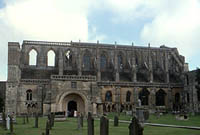| |
 |
Malmesbury (Wiltshire) Malmesbury Abbey |
A monastery was founded at Malmesbury in the 7th century and became famous under its second abbot, St Aldhelm. The present church, which has its origins in c.1170, houses his shrine. Originally the church had an aisled nave, transepts and a crossing tower, but after the Dissolution of the Monasteries in England (1539) the eastern arm was demolished, as was part of the west end.
The nave is of typical late 12th century form with substantial piers of circular cross-section with multi-scalloped capitals and slightly pointed arches.
Of particular interest at Malmesbury is the south porch. The outer doorway has an arch with simple continuous mouldings around it, i.e. there are no capitals between the arch and door jambs. The inner doorway also has continuous arches which are sumptuously carved with, amongst other things, almond-shaped medallions bearing Old and New Testament scenes. The doorway to the church itself is also richly carved with Christ in Glory on the tympanum.
On the east and west walls of the porch are tympana, once painted and gilded, each carved with six apostles and an angel flying above them. The style of carving is thought to show western French influence, but the vigour of the figures and the rendering of emotion on their faces allows these Malmesbury pieces to be set alongside the best Romanesque sculpture in Europe.
Bibliography
Brodie, A.M., 1988. 'Malmesbury Abbey', in Royal Archaeological Institute 134th Summer Meeting, Supplement to Archaeological Journal 145, 31-5
Galbraith, K.J., 1965. 'The iconography of the biblical scenes at Malmesbury Abbey', Journal of the British Archaeological Association, 3rd Ser. 28, 39-56
Pevsner, N., 1975. The Buildings of England, Wiltshire (London, Penguin, 2nd edition revised by B. Cherry), 321 - 7